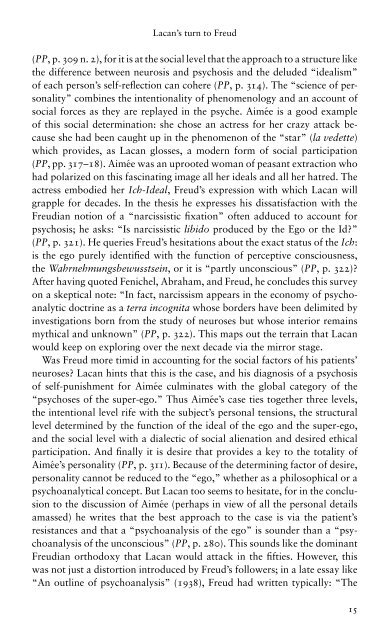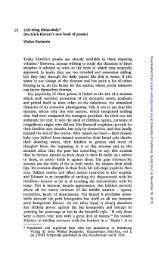X8JKsF
X8JKsF
X8JKsF
Create successful ePaper yourself
Turn your PDF publications into a flip-book with our unique Google optimized e-Paper software.
Lacan’s turn to Freud<br />
(PP,p.309 n. 2), for it is at the social level that the approach to a structure like<br />
the difference between neurosis and psychosis and the deluded “idealism”<br />
of each person’s self-reflection can cohere (PP, p.314). The “science of personality”<br />
combines the intentionality of phenomenology and an account of<br />
social forces as they are replayed in the psyche. Aimée is a good example<br />
of this social determination: she chose an actress for her crazy attack because<br />
she had been caught up in the phenomenon of the “star” (la vedette)<br />
which provides, as Lacan glosses, a modern form of social participation<br />
(PP, pp. 317–18). Aimée was an uprooted woman of peasant extraction who<br />
had polarized on this fascinating image all her ideals and all her hatred. The<br />
actress embodied her Ich-Ideal, Freud’s expression with which Lacan will<br />
grapple for decades. In the thesis he expresses his dissatisfaction with the<br />
Freudian notion of a “narcissistic fixation” often adduced to account for<br />
psychosis; he asks: “Is narcissistic libido produced by the Ego or the Id?”<br />
(PP,p.321). He queries Freud’s hesitations about the exact status of the Ich:<br />
is the ego purely identified with the function of perceptive consciousness,<br />
the Wahrnehmungsbewusstsein, or it is “partly unconscious” (PP, p.322)?<br />
After having quoted Fenichel, Abraham, and Freud, he concludes this survey<br />
on a skeptical note: “In fact, narcissism appears in the economy of psychoanalytic<br />
doctrine as a terra incognita whose borders have been delimited by<br />
investigations born from the study of neuroses but whose interior remains<br />
mythical and unknown” (PP, p.322). This maps out the terrain that Lacan<br />
would keep on exploring over the next decade via the mirror stage.<br />
Was Freud more timid in accounting for the social factors of his patients’<br />
neuroses? Lacan hints that this is the case, and his diagnosis of a psychosis<br />
of self-punishment for Aimée culminates with the global category of the<br />
“psychoses of the super-ego.” Thus Aimée’s case ties together three levels,<br />
the intentional level rife with the subject’s personal tensions, the structural<br />
level determined by the function of the ideal of the ego and the super-ego,<br />
and the social level with a dialectic of social alienation and desired ethical<br />
participation. And finally it is desire that provides a key to the totality of<br />
Aimée’s personality (PP,p.311). Because of the determining factor of desire,<br />
personality cannot be reduced to the “ego,” whether as a philosophical or a<br />
psychoanalytical concept. But Lacan too seems to hesitate, for in the conclusion<br />
to the discussion of Aimée (perhaps in view of all the personal details<br />
amassed) he writes that the best approach to the case is via the patient’s<br />
resistances and that a “psychoanalysis of the ego” is sounder than a “psychoanalysis<br />
of the unconscious” (PP,p.280). This sounds like the dominant<br />
Freudian orthodoxy that Lacan would attack in the fifties. However, this<br />
was not just a distortion introduced by Freud’s followers; in a late essay like<br />
“An outline of psychoanalysis” (1938), Freud had written typically: “The<br />
15







